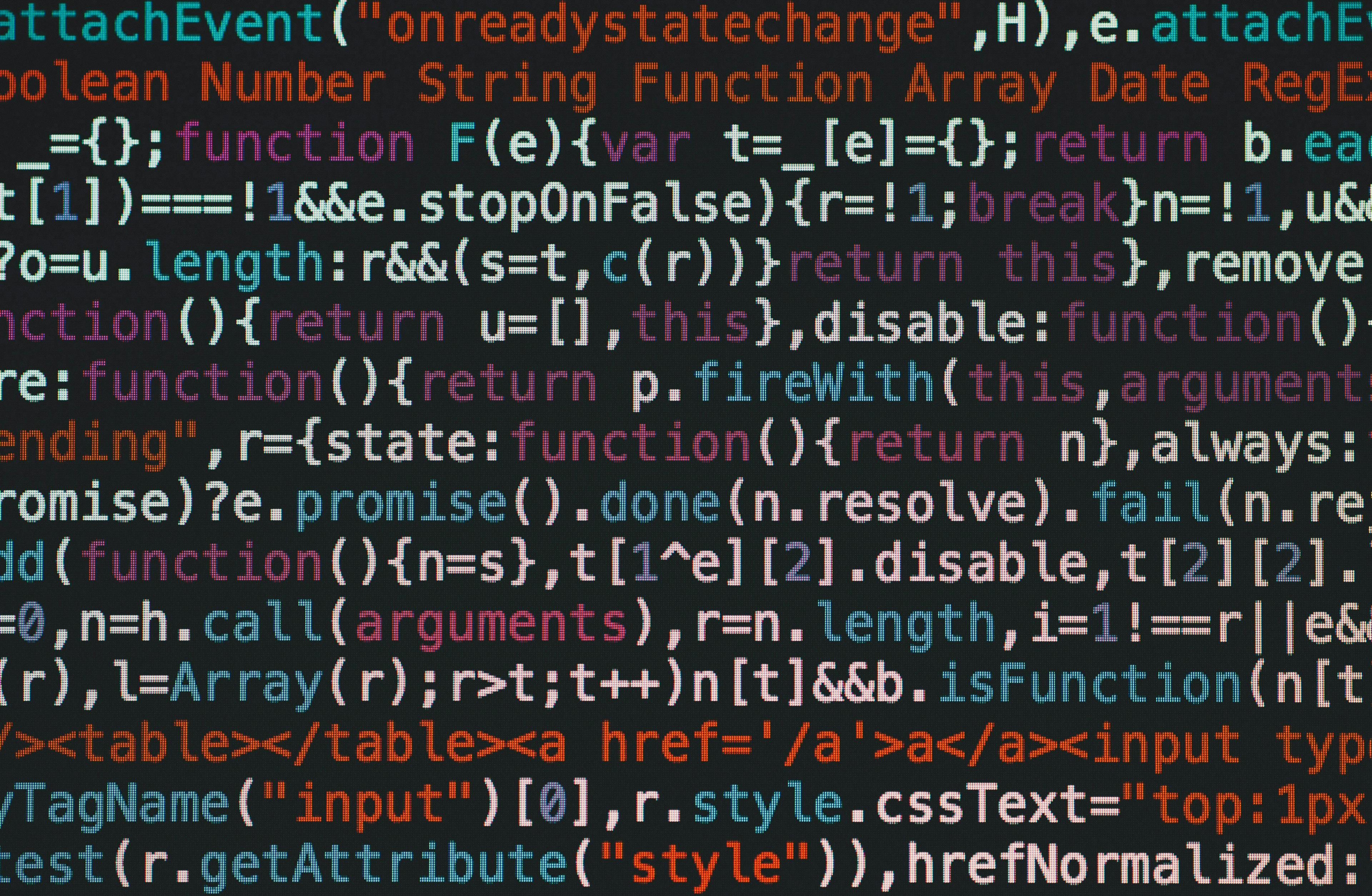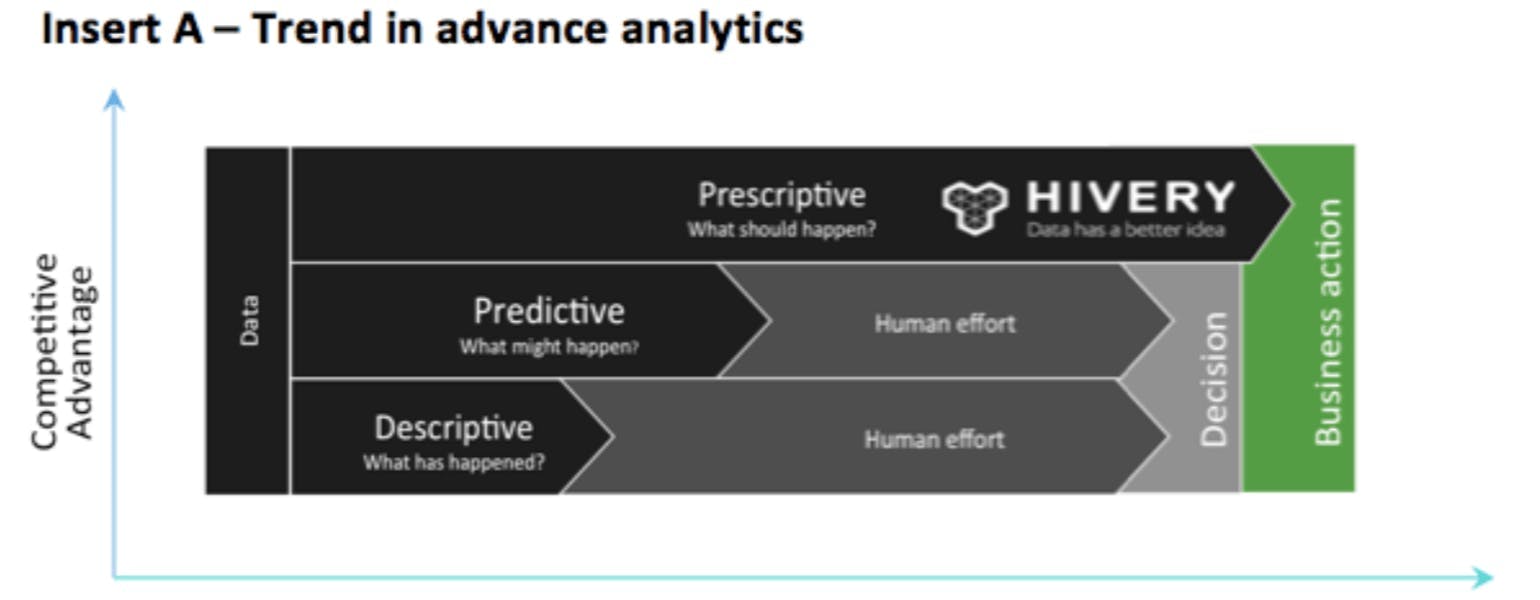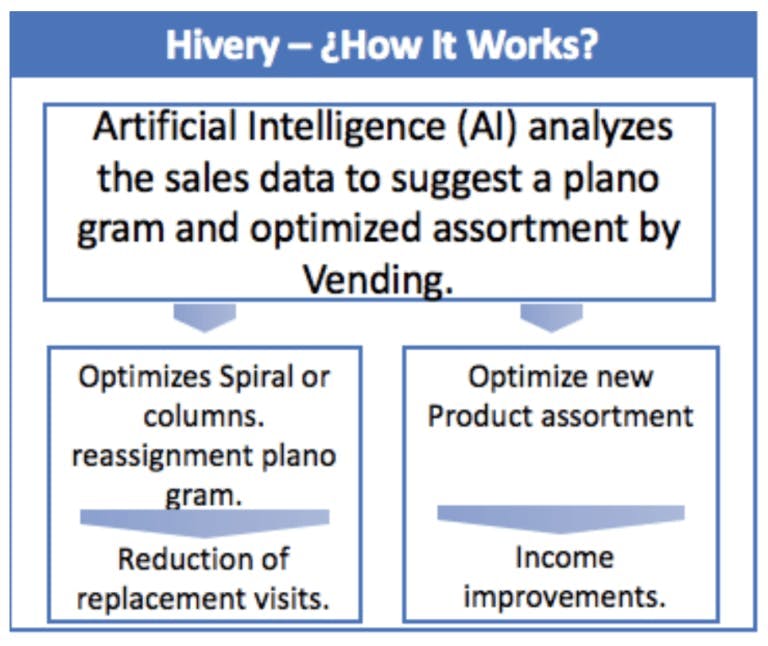
Advanced analytics and artificial intelligence (AI) allow discovering new sources of growth
Sources of sustainable competitive advantage using AI
—
In this paper, I want to address the different types of advanced analytics and how the practical use of Artificial Intelligence (AI) will generate competitive advantage to companies that use it vs. companies that continue to cling to concepts and practices from the past and that will most likely be displaced and replaced.
Let’s start talking about a company, that perhaps in LATAM you have not heard yet, but that very soon it will be totally disruptive in the mass consumption sector
Let’s start talking about a company, that perhaps in LATAM you have not heard yet, but that very soon it will be totally disruptive in the mass consumption sector.
HIVERY is an Australian company in the field of Software as a Service (SaaS) solutions based on the cloud with artificial intelligence (AI) and Machine Learning (ML) algorithms or automated learning, for mass consumption and retail companies, around the world.

HIVERY analyzes millions of data from different consumer and retail businesses with Advanced Analytics, such as Descriptive Analytics (What has happened in the past?). This is the most common of all analytics in business, it provides the analyst with an overview of key metrics and measures within the company. For example, the sales of a product by region per month or a prioritized list of the customers that sell the most. In the evaluation of the descriptive data, the analytical tools of diagnosis will allow the analyst to deepen and, in this way, isolate the root cause of a problem. Why is it happening?
Predictive analytics (What could happen in the future?) Predictive analysis has everything to do with forecasting. Whether it is the probability of an event occurring in the future, forecasting a quantifiable amount, or estimating a point in time at which something could happen, all this is done through predictive models. The best example is in the demand planning forecasts that are made in the Sales and Operational Planning S & OP process.
But by applying Artificial Intelligence (AI) techniques, specifically Machine Learning (ML) algorithms or automatic learning, it helps companies to take advantage of their data in a new way, we achieve a new level of analytics that allows sustainable competitive advantages: Analytics Prescriptive, which, like a doctor would do with his patient, allows optimizing the expected results and defining exactly what we must do to achieve our objectives.
In the case of the Vending Machines business (Vending Machines of Beverages, Snacks or combined), the most common objectives that we find with our customers worldwide are:
- How to increase the income of each vending machine?
- How to reduce the replenishment visits to each vending machine, without losing sales and decreasing the cost of serving?
While the first types of Analytics (descriptive, descriptive with diagnostic analytics and the prescriptive) depend on a human to formulate and prove cause and effect relationships, make a decision with possible bias and impact on business results; The third type of Analytics, the prescriptive with Machine Learning (ML) begins with the business objective first and teaches the “computer” to learn from the historical results to discover the optimal future action to be taken with a limited human participation. This type of analytics has no human participation or cognitive biases that lead to unwanted results.
These learning relationships are incredibly complex; including the execution of hundreds of simulations of “WHAT IF” “What happens? while applying them with the defined and personalized rules of each business; everything done in seconds, and just pressing an optimization button.
The conventional Business Intelligence (BI) techniques of today cannot handle the speed, volume, and variety of data or “Big data”.
This requires new techniques and knowledge.
We are moving away from descriptive analysis and predictive towards the prescriptive. A decision-making system that is always on, always in a self-learning mode, and the more data we feed, the more optimized the objectives. In other words, we are moving from “Big Data” to “Data Intelligent actionable“.
How does Artificial Intelligence (AI) work in an applied case of the Vending Machines business?

In the case of Vending Machines, we developed a Software as a Service (SaaS) solution using a cloud solution called HIVERY Enhance. We always start with the objective or objectives of the business
Vending Analytics uses data from the entire fleet of vending machines and we use a powerful engine driven by artificial intelligence (AI) through machine learning (ML) algorithms to help you achieve, through prescriptive analytics, the optimal combination of an assortment of product and space (planogram) for each of its machines in its fleet.
The commercial lever space (planogram), to be optimized, defining the number of columns or spirals needed for each snack product or beverage flavours, in this way, it is allowed to optimize the total number of replenishment visits per year.
In several practical examples, we were able to reduce the total number of visits per year by up to 18% and simultaneously increasing sales through better product assortment.
In companies that operate vending machines in the United States, the average cost of a visit is the US $ 35. Before the use of our solution, up to 33 visits per year per machine were made. After executing the optimized planogram recommendations, visits were reduced from 33 to 27 visits. A saving per vending machine of 6 visits or 210 USD $ per year.
In the case of Latin America, we find costs for much cheaper visits of up to $ 5 per visit. In this case, the savings is up to $ 30 USD per vending machine per year. A correct planogram allows optimizing the inventory days of each product before it falls into a missing or out of stock (OOS). If static routes are maintained, say visits every 7, 14 or 21 days, it is not possible to achieve these savings. Through dynamic routes, if you can re-plan the visits of each machine and in this way achieve these savings, which at the same time allow you to increase the performance per route by increasing the fill rate% or total units to make refills at each visit averages below 50% and 60% at incredible 80%.
The commercial lever assortment of products, to be optimized, defining which combination of presentations and flavors should go by the vending machine, allows to increase the income of each vending machine, both in units sold per day and in monetary value per day ($).
HIVERY Enhance allows smart substituting the slow rotation products for flavors and presentations with higher sales. In the United States, we have found vending machines that sell an average of USD 5,000 per year, in Latin America due to the lower penetration of vending machines vs. the population, since the existing ones are located in the best locations with the highest consumer-buyer traffic, we can find higher averages of up to $ 6,000 average per machine for beverages and snacks.
When using HIVERY Enhance and optimizing assortment, sales have increased from 15% or more per year, that is, between USD$ 750 and USD$ 900 per vending machine, per year. With gross margins between 45% and 50%, the incremental gross profit could be between USD$ 375 and USD $450. If we add to this the savings per replenishment visit in this way, total profits per vending machine are maximized.
Conclusion
AI through ML algorithms, allows us to augment human decision to maximize the profits of the business where old and moribund concepts such as segmentation are used, which is nothing more than the consequence of the weakness and human inability or human constructs to process millions of data in a few seconds that now machines equipped with AI and ML algorithms can do in an atomized form and allow to discover new sources of growth. The applications are endless.